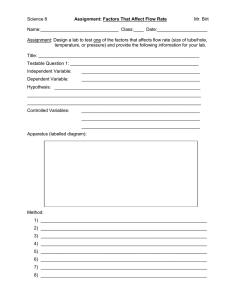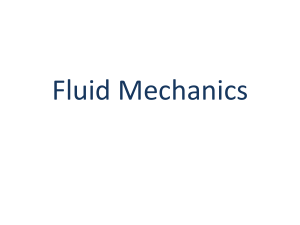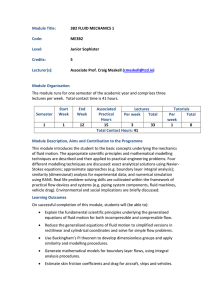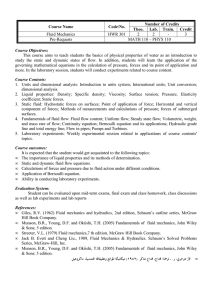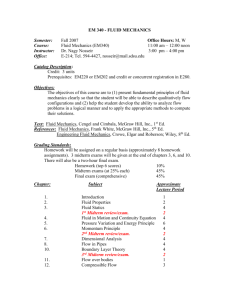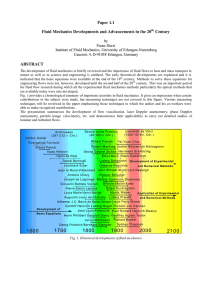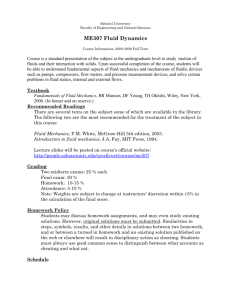Course Outline - Ryerson University
advertisement
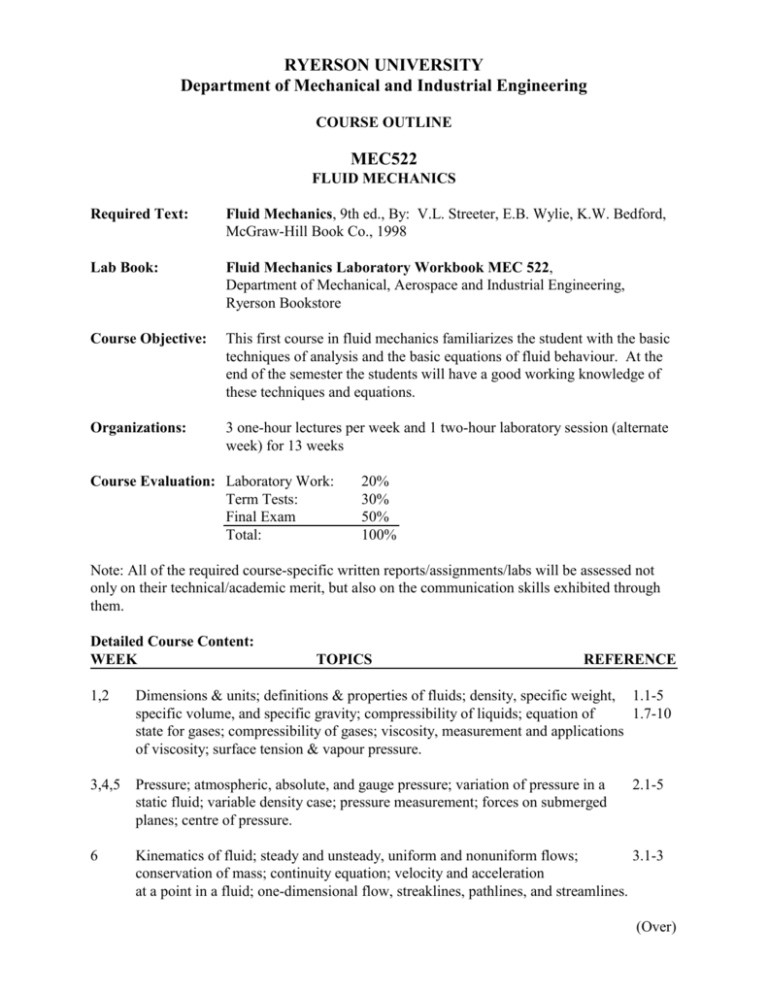
RYERSON UNIVERSITY Department of Mechanical and Industrial Engineering COURSE OUTLINE MEC522 FLUID MECHANICS Required Text: Fluid Mechanics, 9th ed., By: V.L. Streeter, E.B. Wylie, K.W. Bedford, McGraw-Hill Book Co., 1998 Lab Book: Fluid Mechanics Laboratory Workbook MEC 522, Department of Mechanical, Aerospace and Industrial Engineering, Ryerson Bookstore Course Objective: This first course in fluid mechanics familiarizes the student with the basic techniques of analysis and the basic equations of fluid behaviour. At the end of the semester the students will have a good working knowledge of these techniques and equations. Organizations: 3 one-hour lectures per week and 1 two-hour laboratory session (alternate week) for 13 weeks Course Evaluation: Laboratory Work: Term Tests: Final Exam Total: 20% 30% 50% 100% Note: All of the required course-specific written reports/assignments/labs will be assessed not only on their technical/academic merit, but also on the communication skills exhibited through them. Detailed Course Content: WEEK 1,2 TOPICS REFERENCE Dimensions & units; definitions & properties of fluids; density, specific weight, 1.1-5 specific volume, and specific gravity; compressibility of liquids; equation of 1.7-10 state for gases; compressibility of gases; viscosity, measurement and applications of viscosity; surface tension & vapour pressure. 3,4,5 Pressure; atmospheric, absolute, and gauge pressure; variation of pressure in a static fluid; variable density case; pressure measurement; forces on submerged planes; centre of pressure. 6 2.1-5 Kinematics of fluid; steady and unsteady, uniform and nonuniform flows; 3.1-3 conservation of mass; continuity equation; velocity and acceleration at a point in a fluid; one-dimensional flow, streaklines, pathlines, and streamlines. (Over) 7,8,9 Energy considerations in flowing fluids; Euler & Bernoulli equations; kinetic, potential, and pressure energies; losses, external work; applications of the Bernoulli equation; stagnation Pitot tubes; piping systems with pumps, turbines and losses; the Moody diagram. 3.4-6 6.7-8 10 3.7 Impulse-momentum considerations; forces of jets; forces on bends, elbows, and vanes. 11, 12 Dimensional analysis and similitude; units & dimensions; fundamental 5.1-3 dimensions; MLT system; dimensional analysis, Buckingham theorem & method; 5.6 dimensionless numbers: Reynolds, Froude, Euler, Weber, and Mach numbers; model testing; similitude; geometric, kinematic, and dynamic similarity, etc. 13 Allowance for tests, course review, etc. Lab Experiments: 1. Viscosity Measurement 2. Reynolds Apparatus 3. Energy & Hydraulic Gradients 4. Pipe Friction 5. Weirs and Flow Measurement Laboratory Reports: Laboratory reports are submitted for each experiment. A penalty is imposed for late submission of reports. Only students present for the full duration of the experiment will receive credit. Term Tests and Examination Details: Term tests to be held on or about week 6 & 11 (15% per test), and are open book. Final Examination to be held during the examination period, and is also open book. Faculty Course Survey: Students will be requested to complete this survey during the weeks of 10, 11 or 12. Prepared by: Date: June 12, 2003 Date: Aug. 2003 W. Leong Approved by: L. Fang

